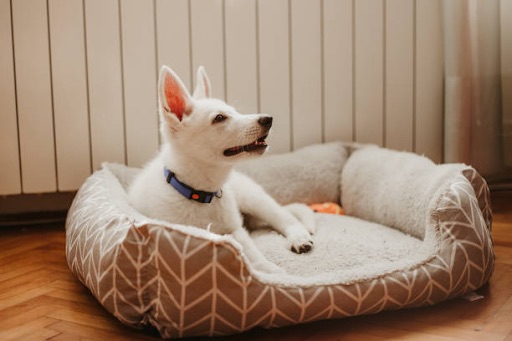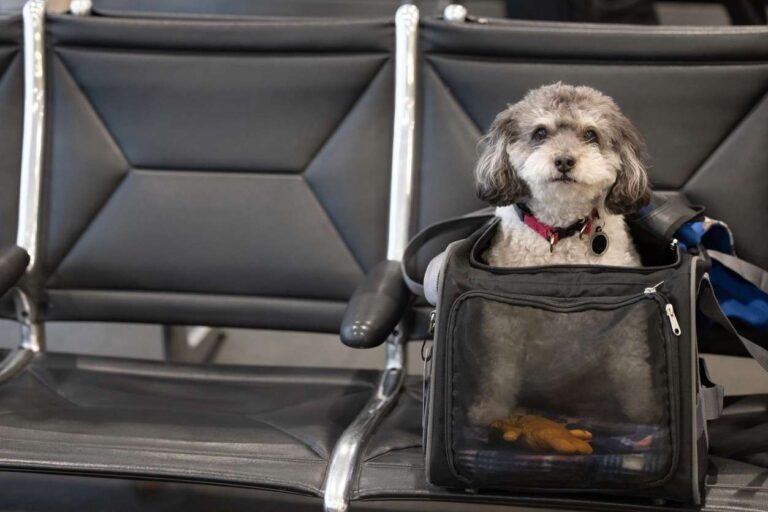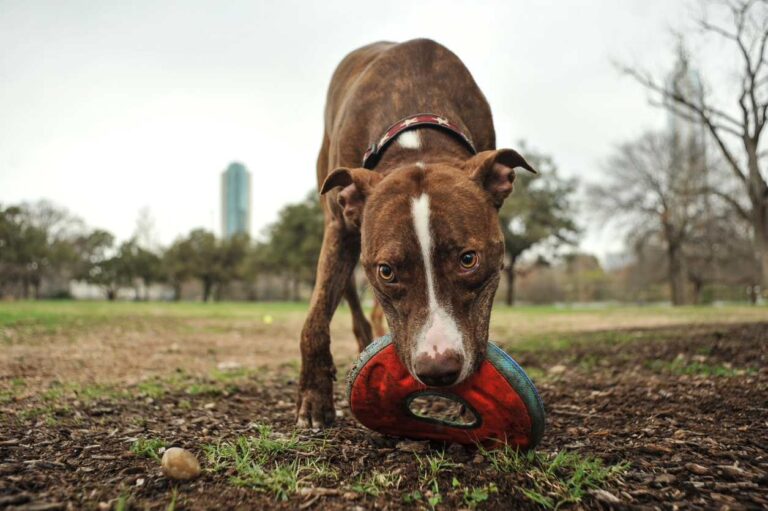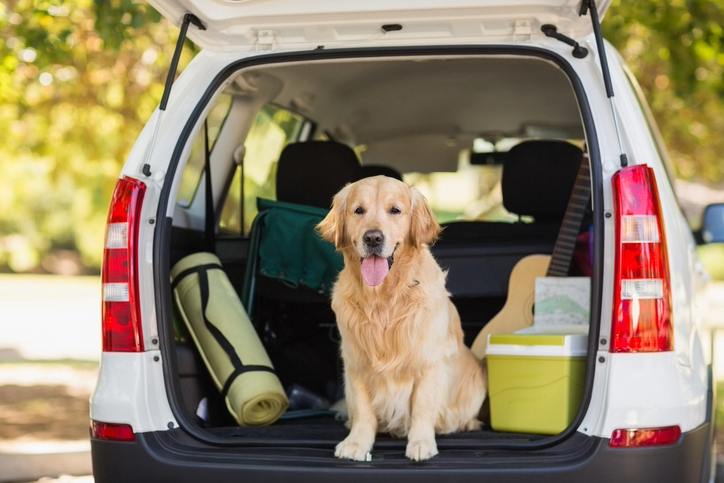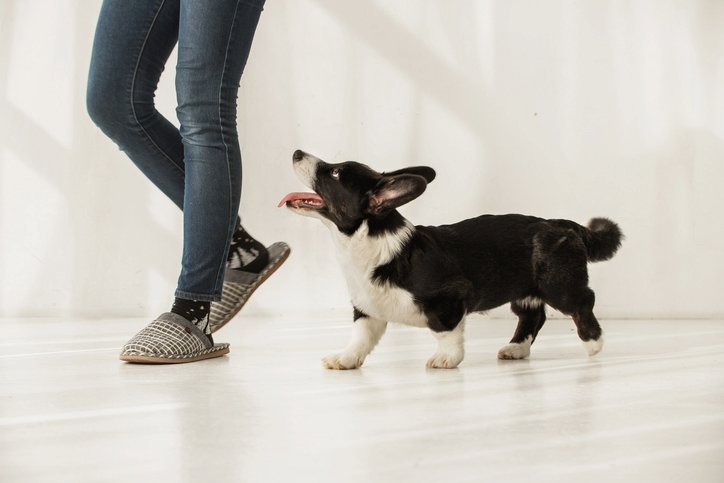“Place” is a client-favorite command, and we’re here to give you a behind-the-scenes look at introducing this obedience behavior. At Beyond the Dog, we define place as “go to your bed and stay there until you are released.” It doesn’t matter if your puppy or dog is sitting, laying down, or even chewing on a toy as long as all four paws are on the bed. We recommend a bed with raised edges for this reason so your pet can easily tell when they are still in the bed or when they are pushing the boundaries by starting to slide out. The “place” command is taught in two parts; send them to “place,” then reinforce them for staying on “place”. For each of these actions, trainers use a lure to teach the initial steps of the command, transition to a hand signal once they understand the basics, and finally introduce a verbal command to fade out food and secondary cues.
You can use “place” for:
- Guests coming over
- Making and/or eating dinner
- During downtime (doing chores around the house or relaxing)
- Doing dishes
- Folding laundry
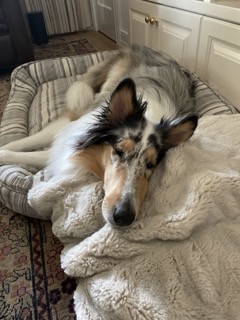
Using a lure
The first step is to take your puppy or dog through the motions. Make sure your puppy is wearing a secure collar and a short leash.
- Stand about one foot away from the bed. Use your arm closest to the bed when practicing this motion. Hold a piece of food or a treat between your thumb and forefinger.
- Show the treat to your puppy by holding it in front of their nose. Slowly enough to encourage your puppy to follow, move your arm across your body (keeping it extended) and over the dog bed.
- Once their fourth paw touches the bed, mark the completion of the behavior by using a word like “yes!” or “good!”.
- We call this word a “bridge word” because it gaps the time between when we mark a successful command and when they receive a treat for it.
- After you “bridge” (say the word), give your puppy their piece of food or treat.
- Designate a release word for your pet. This could be something like “release,” “free,” or “okay”.
- Say the word you have decided on, and toss a second treat away (off the bed).
- Repeat this process 8-12 times.
You should notice your puppy walking towards the bed more quickly and more confidently entering or hopping onto their bed over time.
Teaching a hand signal
The next step in teaching the “place” command is to begin fading out the food. You will complete the same steps listed above but start by having the treat in your opposite hand.
- Stand roughly 1ft from the bed with the puppy on your other side
- Prepare to gesture with your dominant hand (arm closest to the bed) but hold the food in your non-dominant hand (arm closest to the puppy)
- Shape your hand to look like you have a treat between your fingers
- Move your hand in front of your puppy’s nose and slowly move it towards and over the dog bed
- Use your marker word as soon as the puppy’s fourth paw touches the bed
- Feed them with the treat in your other hand while they are still on the bed
- Use your release word and praise them or clap your hands to coax them back off of the bed (without using food now)
- Repeat 8-12 times
The more repetitions you practice, you will be able to slowly evolve the shape of your hand to just be a pointing gesture (rather than making it look like you are holding a treat). With consistent practice, you can fade out the food even further. These steps involve having the treat in your non-dominant hand. Next, you can try holding your non-dominant hand behind your back, and eventually keeping the treat in a treat bag behind your back and only reaching for it after you use your bridge word. You should notice your puppy is able to wait on their bed patiently for the treat. If they cannot wait or get off the bed early in anticipation of the food, back up a step and practice a little more before advancing again. All puppies will advance at different paces depending on how food-motivated they are, how hungry they might be, how quickly they catch on, how old they are, their energy level, etc. Every puppy is unique and it’s important to be patient with them and make sure we are setting them up for success.
Introduce the verbal command
The last step is to actually start using the word “place” so your puppy can make a direct association with their bed. You will know your puppy is ready for the verbal command if they successfully follow your hand signal 80-90% of the time. Your puppy might even begin to run or jump excitedly onto their bed before you can even begin to point!
To introduce the “place” command correctly, get your puppy’s attention and say “(your puppy’s name), place” BEFORE you use a hand signal. Wait 2-3 seconds to give them a chance to go. If they do, celebrate!! Bridge and treat them, and continue practicing. If they don’t go right away, that’s okay. Without repeating the verbal command, use your hand signal and give them a second chance to comply with the command. When they do, use your marker word and feed as normal. Our goal with introducing the command is to only say it one time and eventually reward your puppy for going after the verbal command but before the hand signal.
Staying on place
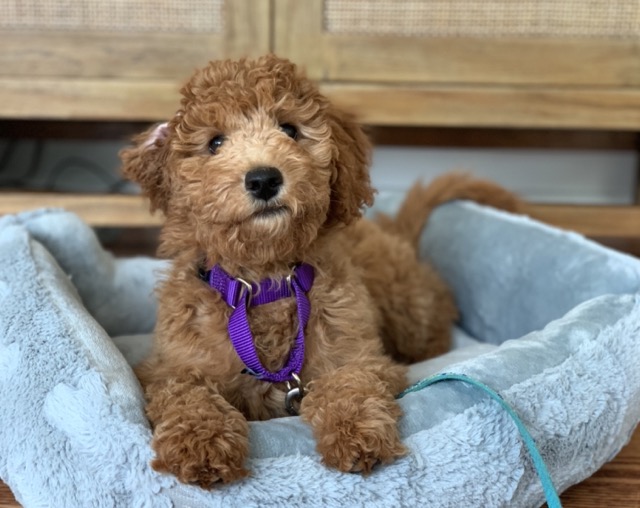
Once your puppy has the verbal command nailed down, you can begin to practice having them stay on the bed for longer periods of time. To do this, we will practice the 5 D’s of training. These are:
- Distance
- Duration
- Distractions
- Direction
- Disappearance
Once your puppy is on “place,” you have bridged and treated, do not release them, and don’t hold the leash. Instead, you will start to incorporate the 5 D’s and use your bridge word every time it is most difficult for your puppy.
Distance is slowly increasing the distance between you and your puppy. Duration is ‘x’ amount of time your puppy is on “place” or increasing the time between treats. Distractions can range from anything to dropping a treat on the ground, throwing a favorite toy, answering the door, or doing kitchen chores. Direction and disappearance will occur naturally as you increase the distance between you and your puppy and walk in a different direction or go out of sight.
Target ONE of these D’s at a time, and every time you increase the difficulty and your puppy is successful, bridge, return to them, feed them, and repeat. You do not need to release your puppy between each repetition and re-send them to place. For example, take 2 steps back from the bed, say “good!” and return to your puppy to feed them. Walk 4 steps back, bridge, and treat. Continue to repeat until you can walk all the way across the room and your puppy remains on the bed!
It is more important to advance slowly with many successes rather than progress too quickly and come into contact with frequent failure. Slow and steady wins the race!
We hope you have fun teaching your puppy obedience and enjoy the benefits that the time spent practicing and bonding can offer. Friends and family are always so impressed when a puppy waits patiently on their bed while they come in the door or while dinner is being served. If you would like one of our certified dog trainers to help, contact us today! We can work one-on-one with you and your puppy so you can experience the positive impact training can have on your everyday life.
